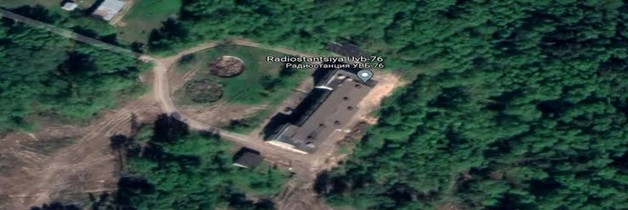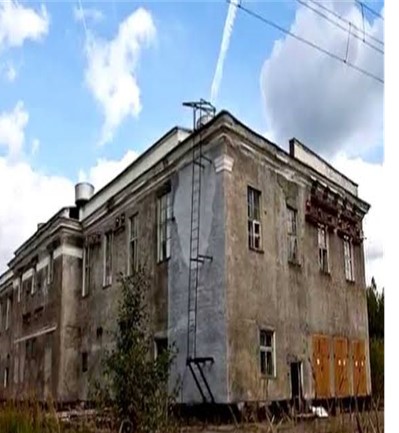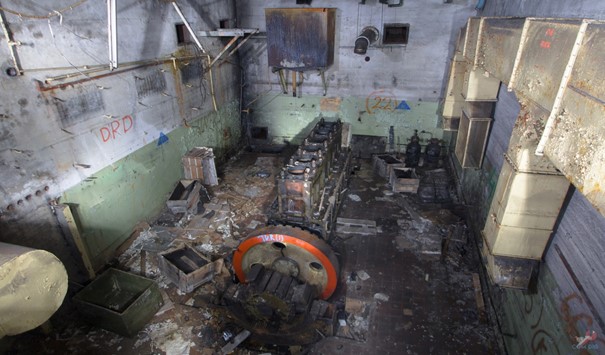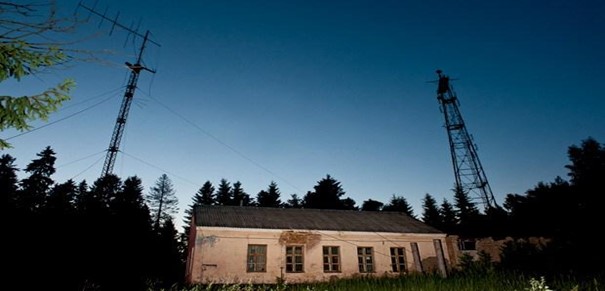Throughout history, humans have been intrigued by mysterious, astonishing, and captivating events, relentlessly pursuing and investigating them. Despite the fear they may evoke, our curiosity and thrill have never waned. In this article, we will delve into one of Russia's greatest mysteries – the Ghost Radio Station, UVB-76.

UVB-76: The Buzzer
What Is UVB-76?
UVB-76, also known as "The Buzzer," is a shortwave radio station broadcasting on the frequency 4625 kHz. It emits a short, monotonous buzzing tone repeated at a rate of approximately 25 tones per minute, 24 hours a day. Occasionally, the buzzing signal is interrupted, and a Russian voice transmission takes place. The exact start date of the broadcast is debated, but it is believed to have begun in the late 1970s, possibly in 1976.
Location and Emergence of UVB-76:
Situated not far from St. Petersburg, Russia, in the midst of swampy terrain, lies a rectangular iron gate. Behind its rusty bars, there are radio towers, abandoned buildings, and electric lines surrounded by a dry stone wall. This place is thought to be the center of the enigmatic "MDZhB" radio, the management of which remains unknown. For the past 35 years, it has been broadcasting a monotonous sound seven days a week, 24 hours a day. Despite occasional human voices heard, the station's current location remains unknown.
On June 5, 2010, UVB-76 reportedly remained silent for about 24 hours, only to return to normal on the morning of June 6.
No matter where in the world, anyone tuning their radio to the frequency 4625 kHz can listen to this broadcast. Everyone adjusting their radio can listen to The Buzzer. The station uses Amplitude Modulation (AM) with suppressed lower sideband (USB modulation) for transmission, and it has also used full double-sideband AM (A3E). The signal consists of a buzzing sound lasting 1-2 seconds, pausing for 1-1.3 seconds, and repeating 21–34 times per minute. Until November 2010, each buzzing tone lasted approximately 0.8 seconds. An hour before the top of the hour, the repeating tone was previously replaced with a continuous alternative tone; although it ended in June 2010, it continued for a minute until the short repeating buzz resumed.

Russia's Most Mysterious Facility!
Since it began broadcasting in the 1970s, the buzzer transformed into a recurring two-second beep reminiscent of a bell in the late 1980s/early 1990s. For a brief period, it changed to a longer, higher tone (approximately 20 tones per minute) on January 16, 2003, but it reverted to the previous tone model since then. The duration and depth of these buzzes increased over time, and disruptions became more frequent, suggesting the possibility that the buzzing might be mechanically generated. In a malfunction in 2016, a noticeable sound of someone ringing a mechanical bell could be heard, indicating that the transmissions are typically monitored 24/7.
UVB-76 and Conspiracy Theorists
The radio is so mysterious, it seems as if it were specifically designed for conspiracy theorists. The radio station has tens of thousands of followers who affectionately refer to it as "Buzzer." Fans openly admit they have no idea what they are listening to.
In reality, no one knows what this radio is doing. David Stupples, an electronic intelligence system expert from City University in London, says, "There is no information in the signal."
Is UVB-76 for Nuclear Attack?
The frequency is believed to belong to the Russian military, but the Russian military has never officially acknowledged it. The radio broadcasts began at the end of the Cold War, during a period when communism was on the decline.
Today, it broadcasts from two separate locations: the site near St. Petersburg and the vicinity of Moscow. Strangely, after the collapse of the Soviet Union, instead of shutting down, the radio's activities intensified.
The theories about what Buzzer is used for are endless. Some suggest its purpose is to be in contact with submarines or communicate with aliens. One theory even suggests that if Russia were to experience a nuclear attack, the broadcast would cease, triggering an automatic retaliation. According to this theory, both the attacker and the target would be annihilated with nuclear weapons.

Image of the facility where UVB-76 is still broadcasting
What Are the Characteristics of UVB-76 Signal?
This probability is not actually as bizarre as it might seem. During the Soviet Union era, a system was developed to scan broadcast frequencies, searching for signs of life or traces of nuclear conflict. This system, referred to as "dead hand" in the West, was later transformed into a computer system that would trigger retaliation in the event of a nuclear attack. Alarmingly, many experts believe that it might still be in use.
As Russian President Vladimir Putin has mentioned, in a nuclear war between Russia and the United States, "no one would survive." Could the Buzzer be preventing such a possibility?
In fact, there are some clues provided by the signal itself. Like most international radio broadcasts, the Buzzer transmits on a relatively low frequency known as shortwave. Compared to local radio, mobile phone, and television signals, the wave count passing through a single point per second is lower. Therefore, radio waves can reach much greater distances.
While struggling to listen to a local radio from a neighboring region, such as BBC London, radios broadcasting on shortwave, like BBC World Service, reach many listeners from Senegal to Singapore. However, both stations may be broadcasting from the same building.

You can follow the sounds of the radio live on YouTube!
UVB-76 and the Dead Hand Theory
When an event is mysterious and no explanations are provided, conspiracy theorists continue to speculate about this station for years.
Some claim that the UVB-76 station is used by Russia to communicate with its intelligence agents worldwide, while others suggest that the station is actually the 'Dead Man's Hand,' asserting that in the event of a nuclear threat, the broadcast on the station would cease, triggering automatic retaliation.
As the debate over 'nuclear' continues between Russia and all countries worldwide, UVB-76 seems to remain a topic of discussion, maintaining its mystery.
High-frequency radio signals move in a straight line and disappear when they encounter obstacles or reach the horizon. Shortwave radio signals, on the other hand, can bounce off charged particles in the upper part of the atmosphere, zigzagging between the earth and the sky and reaching thousands of kilometers away.
This brings us back to the "Dead Hand" theory. As you can imagine, shortwave signals are extremely popular. Today, they are used in military communications that cross oceans, mountains, ships, and planes.
However, there is a crucial point to note. Shortwave behaves like waves on the ocean. It has moments of rising and falling. It rises during the day and falls at night. If you want to ensure that your broadcasts are heard from the other side of the world, especially if you aim to signal a nuclear war, you need to change the frequency based on the time of day. BBC World Service does this, but the Buzzer does not.
Another idea is that the radio station might be used to determine how far away the layer of charged particles is.
Another Radio Channel Resembling UVB-76 Buzzer
Interestingly, there was another radio station that closely resembled the Buzzer. This radio, broadcasting from the mid-1970s until 2008, could be heard from the other side of the world, just like the Buzzer. Similar to the Buzzer, it transmitted from an undisclosed location, believed to be in Cyprus. Also, like the Buzzer, its broadcasts were peculiar.
Every hour, the radio played the opening of the English folk tune "Lincolnshire Poacher." After repeating this 12 times, a mechanical female voice with a sophisticated British accent would recite a group of five numbers, saying, "1-2-0-3-6."
UVB-76's Trail Extends to the Past
In May 1927, following a British agent's observation of one of his officials entering a news bureau affiliated with the communists in London, England raided the Arcos building in London. The basement of the building was filled with devices designed to detect those entering secretly, and inside, workers were hastily trying to burn some documents. Additionally, a hidden room without a doorknob was discovered.
It could have been dramatic, but the British already knew about these activities. The Arcos raid was a surprise to the Soviets, who discovered that the main British intelligence service had been listening to them for years. As a result, the Russians completely changed the way they encrypted messages. Almost overnight, they switched to using one-time pads. In this system, the person sending the message generated a random decryption key, sharing it only with the person who would read the message. As long as the key was truly generated completely randomly, breaking the code was impossible. The Russians no longer had to worry about who might be listening to their messages.
This is where "number stations" came into play. These stations broadcast encrypted messages to spies worldwide. Soon, even the British resorted to the same method, based on the logic of "if you can't beat them, join them."

What is the latest sound heard from UVB-76? Clearly audible are the repetitions of "Anna Nikolai Vasily Fyodor Anna Nikolai Vasily Fyodor 11 17 36 76" by a Soviet soldier accompanied by static. This code, uttered on October 5, 2020, has been recorded by some amateur radio enthusiasts and broadcasted on YouTube.
Does UVB-76 Only Activate in Crisis?
The idea of the Buzzer transmitting messages to Russian spies worldwide is intriguing, but there's a catch. The Buzzer has never broadcasted messages containing numbers so far.
Instead, some believe it serves two functions. The continuous tone it broadcasts is a signal saying, "this frequency is mine, this frequency is mine..." to prevent others from using it. During crises, such as a Russian invasion, it may transform into a station broadcasting numbers.
At that time, it could instruct global spy networks and military forces in the country's remotest regions. After all, Russia is approximately 70 times the size of the United Kingdom.
"COMMAND 135 EMERGED" Message
It seems they are already practicing. Radio enthusiast Māris Goldmanis, who listens to the station from his home in a Baltic country, says, "In 2013, they broadcast a special message saying 'COMMAND 135 EMERGED,' and it was said to be a test message to be prepared for war." However, the purpose of the station has not been confirmed by the government or broadcast officials.
Nevertheless, former Minister of Communications and Informatics of the Republic of Lithuania, Rimantas Pleikys, wrote that the purpose of the voice messages is to confirm that operators at receiving stations are alert.
The lack of clear information about this radio station continues to make its mysterious nature even more intriguing.
IF YOU WANT TO LISTEN TO THE SOUND OF THE RADIO, YOU CAN ACCESS IT FROM THIS LINK:
https://youtube.com/shorts/B-X26VJsjFY?si=gd5zSy382XJjGE0W
REFERENCES:
https://www.sciencetimes.com/articles/44910/20230717/uvb-76-russian-military-radio-station-mystery-why-sending-strange.htm
https://www.iflscience.com/infamous-russian-number-station-uvb76-begins-sending-strange-messages-62319
https://indigodergisi.com/2018/01/uvb-76-rusya-radyo-istasyonu/
Keywords: Ghost Radio, UVB-76, Radio Station, The Buzzer, Buzz, Soviet Union, Russia
Orhan Açıkgöz
Yücel Cultural Foundation
Voluntary Author
translated by Ekremcan Bakır
YKV Content:1519